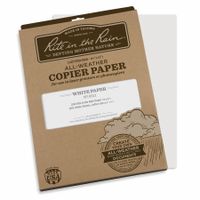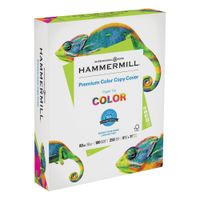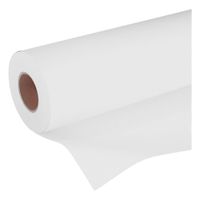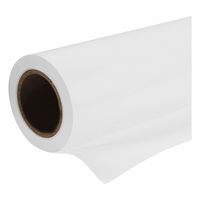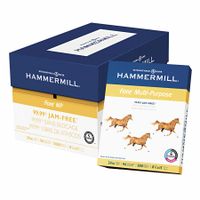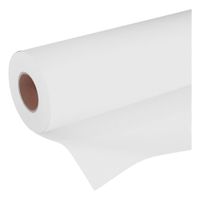Call +(254) 703 030 000 / 751 483 999 / 721 704 777
- Home
- Office Supplies
- Office Paper Notebooks
- Copy Printer Paper
.....Read More
Frequently Asked Questions
What is the standard size of copy and printer paper?
The standard size of copy and printer paper, commonly referred to as "letter size" in the United States and Canada, is 8.5 x 11 inches (215.9 x 279.4 mm). This size is widely used for a variety of documents, including letters, forms, and reports. In other parts of the world, particularly in countries that follow the International Organization for Standardization (ISO) standards, the most common paper size is A4, which measures 210 x 297 mm (8.27 x 11.69 inches).
The letter size paper is part of the North American paper size system, which also includes other sizes like legal (8.5 x 14 inches) and tabloid (11 x 17 inches). The A4 size is part of the ISO 216 standard, which includes a range of sizes such as A3 (297 x 420 mm) and A5 (148 x 210 mm).
The choice between letter and A4 sizes often depends on regional preferences and the specific requirements of the task at hand. For instance, businesses in the U.S. typically use letter size for internal documents, while international correspondence might require A4 to ensure compatibility with global standards.
Both letter and A4 sizes are designed to be easily handled, stored, and printed, making them ideal for everyday office use. They are compatible with most printers, copiers, and fax machines, which are typically configured to accommodate these standard sizes.
How is photo paper different from standard printer paper?
Photo paper differs from standard printer paper in several key aspects, primarily designed to enhance the quality and durability of printed photographs.
1. **Coating**: Photo paper is coated with a special chemical layer that absorbs ink more effectively, allowing for vibrant colors and sharp details. This coating can be glossy, semi-gloss, or matte, affecting the finish and texture of the printed image.
2. **Weight and Thickness**: Photo paper is generally heavier and thicker than standard printer paper. This added weight helps support the ink and prevents warping or curling, which is crucial for maintaining the integrity of the photograph.
3. **Brightness and Whiteness**: Photo paper is often brighter and whiter than standard paper, enhancing color contrast and making images appear more vivid. The high brightness level helps in achieving true-to-life colors and better image clarity.
4. **Ink Absorption**: The coating on photo paper is designed to absorb ink quickly and evenly, reducing the risk of smudging and allowing for high-resolution printing. This is particularly important for capturing fine details in photographs.
5. **Durability**: Photo paper is more resistant to fading and damage from light exposure compared to standard paper. This durability ensures that printed photos maintain their quality over time.
6. **Surface Texture**: The surface texture of photo paper can vary, offering different aesthetic effects. Glossy finishes provide a shiny, reflective surface, while matte finishes offer a non-reflective, smooth appearance.
7. **Purpose**: Photo paper is specifically engineered for printing photographs, whereas standard printer paper is designed for text documents and general use. The specialized nature of photo paper makes it ideal for producing high-quality photographic prints.
These differences make photo paper the preferred choice for printing images where quality and longevity are important.
What is the purpose of colored multipurpose printer paper?
Colored multipurpose printer paper serves several purposes, enhancing both functionality and aesthetics in various settings. Primarily, it is used to improve organization and communication. By assigning different colors to specific types of documents or departments, businesses and educational institutions can streamline processes and reduce errors. For instance, invoices might be printed on blue paper, while memos are on yellow, making it easier to quickly identify document types.
In marketing and presentations, colored paper adds visual appeal, helping to capture attention and convey messages more effectively. It can be used for flyers, brochures, and promotional materials, where the color can evoke emotions or align with brand identity. This is particularly useful in advertising, where standing out is crucial.
In educational settings, colored paper can be used to differentiate between subjects or grade levels, aiding both teachers and students in organization. It can also be used for creative projects, enhancing the learning experience by making it more engaging.
Additionally, colored paper is often used in arts and crafts, providing a versatile medium for creative expression. It is suitable for making greeting cards, decorations, and other handmade items, offering a wide range of colors to suit any project.
In summary, colored multipurpose printer paper is a versatile tool that enhances organization, communication, and creativity across various domains. Its ability to differentiate, attract attention, and add aesthetic value makes it an essential resource in both professional and personal contexts.
How does all weather printer paper work?
All-weather printer paper is designed to withstand exposure to water, moisture, and other environmental conditions that would typically damage regular paper. This type of paper is often used in outdoor settings, such as construction sites, field research, or any situation where documents need to be durable and legible despite adverse weather conditions.
The key to all-weather paper's functionality lies in its unique composition and coating. It is typically made from a synthetic material, such as a polyester or polypropylene blend, which inherently resists water. This synthetic base provides a durable, tear-resistant quality that regular paper lacks.
Additionally, all-weather paper is often coated with a special waterproofing agent. This coating repels water, preventing it from soaking into the paper and causing ink to run or the paper to disintegrate. The coating also allows for writing with pencils, pens, or specialized all-weather inks, ensuring that markings remain clear and legible even when wet.
Some all-weather papers are designed to work with laser printers, which use heat to fuse toner onto the paper. The synthetic material can withstand the high temperatures of laser printing without melting or warping. However, not all all-weather papers are suitable for inkjet printers, as the water-based inks can have difficulty adhering to the waterproof surface.
Overall, all-weather printer paper combines synthetic materials and specialized coatings to provide a durable, water-resistant solution for printing needs in challenging environments.
What is cleanroom paper used for?
Cleanroom paper is specifically designed for use in controlled environments where contamination control is critical. It is used in industries such as pharmaceuticals, biotechnology, electronics, aerospace, and semiconductor manufacturing. The primary purpose of cleanroom paper is to minimize the risk of particle generation and contamination, which can compromise the integrity of sensitive processes and products.
Cleanroom paper is manufactured from specially treated materials that reduce the release of particles and fibers. It is often made from cellulose or synthetic fibers and is treated to resist static charge, which can attract dust and other contaminants. The paper is also designed to be low-linting, meaning it does not shed particles easily, making it suitable for use in environments where maintaining cleanliness is essential.
In cleanrooms, this paper is used for documentation, note-taking, and printing purposes. It is compatible with various writing instruments and printers, ensuring that personnel can record data and information without introducing contaminants. Cleanroom paper is also used for packaging and wrapping sensitive components, providing a barrier against contamination during storage and transport.
Additionally, cleanroom paper is often used in conjunction with cleanroom notebooks, binders, and labels, all of which are designed to meet the stringent requirements of controlled environments. By using cleanroom paper and related products, industries can maintain the high standards of cleanliness necessary to ensure product quality and safety.
How can metal-detectable and magnetic paper prevent product contamination?
Metal-detectable and magnetic paper can prevent product contamination by integrating materials that are easily identifiable by standard detection systems used in food and pharmaceutical industries. These papers are embedded with metal or magnetic particles, allowing them to be detected by metal detectors and magnetic separators commonly used in production lines.
When a piece of metal-detectable or magnetic paper inadvertently enters the production process, it can be quickly identified and removed, preventing it from contaminating the final product. This is crucial in maintaining product safety and quality, as undetected foreign materials can pose health risks to consumers and lead to costly recalls and damage to brand reputation.
The use of such detectable papers is particularly beneficial in environments where paper is frequently used for labeling, packaging, or as part of the production process. By ensuring that even small fragments of paper can be detected, manufacturers can significantly reduce the risk of contamination.
Moreover, these papers are designed to be compatible with existing detection systems, meaning that companies do not need to invest in new equipment to implement this safety measure. This makes it a cost-effective solution for enhancing product safety.
In summary, metal-detectable and magnetic paper serve as an effective preventive measure against product contamination by ensuring that any paper-based materials that accidentally enter the production process can be easily detected and removed, thereby safeguarding consumer health and maintaining product integrity.
What are wide-format paper rolls used for?
Wide-format paper rolls are primarily used in industries and applications that require large-scale printing. These include:
1. **Architectural and Engineering Plans**: Used for printing blueprints, schematics, and technical drawings. The large size accommodates detailed designs and annotations.
2. **Advertising and Marketing**: Essential for creating large banners, posters, and signage. They are used in retail environments, trade shows, and outdoor advertising to capture attention with vibrant, large-scale visuals.
3. **Art and Photography**: Artists and photographers use wide-format paper for high-quality prints of artwork and photographs. This allows for detailed and large reproductions suitable for galleries and exhibitions.
4. **CAD and GIS Applications**: In computer-aided design (CAD) and geographic information systems (GIS), wide-format paper is used to print maps, layouts, and spatial data that require precision and clarity.
5. **Event and Exhibition Graphics**: Used to produce backdrops, displays, and other visual materials for events and exhibitions, providing impactful and immersive experiences.
6. **Interior Design**: Designers use wide-format prints for wallpaper, murals, and other decorative elements that require seamless, large-scale imagery.
7. **Educational and Training Materials**: Schools and training centers use wide-format prints for educational charts, diagrams, and instructional materials that need to be visible to large groups.
8. **Vehicle Wraps and Decals**: Specialized wide-format paper is used in the production of vehicle wraps and decals, allowing for custom designs that cover large surface areas.
9. **Textile Printing**: In the fashion and textile industry, wide-format paper is used for printing patterns and designs on fabrics.
These applications benefit from the ability to produce large, continuous prints without seams, ensuring high-quality, professional results.
